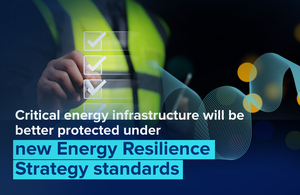New Energy Resilience Strategy to better protect infrastructure
A new government strategy will help safeguard critical energy infrastructure and protect consumers and businesses from costly disruption.

- The government took swift action to bolster Britain’s energy resilience following the North Hyde substation fire in March, including commissioning the National Energy System Operator (NESO) to investigate
- NESO’s recommendations are already being implemented across the energy system and will lay the foundations for a new first of its kind Energy Resilience Strategy
- the strategy will set out priorities for safeguarding critical energy infrastructure such as substations and cables against evolving risks
A new government strategy will help safeguard critical energy infrastructure and protect consumers and businesses from costly disruption.
Energy Minister Michael Shanks has today (18 November) announced that a first of its kind comprehensive Energy Resilience Strategy will be published next year to future proof the energy system to address the evolving risks the sector faces, including climate change impacts, cyber threats, and geopolitical tensions.
It follows a fire at National Grid’s North Hyde substation in March which led to widespread disruption at Heathrow Airport. The government took immediate action to commission the independent National Energy System Operator (NESO) to investigate the fire and Britain’s energy resilience more broadly.
This investigation concluded in July, with NESO confirming that fire was most likely caused by moisture in the substation equipment resulting in an electrical fault, alongside a series of recommendations to reduce the likelihood and impact of this kind of incident in the future.
Britain’s energy infrastructure is designed to last for decades, but ageing assets need to be monitored and tested to ensure they continue to operate effectively.
The government is bolstering standards and expectations, with requirements for regular testing and maintenance, alongside wider plans to upgrade Britain’s energy networks after decades of underinvestment.
As part of the full response to NESO’s report, government is already working with NESO and industry to ensure that all of NESO’s 12 recommendations are implemented. This includes reviewing maintenance procedures for key energy infrastructure to ensure assets like substations are inspected regularly and issues are addressed promptly. Collaboration between energy operators, emergency services and the wider industry will also be strengthened during incidents so power can be restored as quickly as possible.
Energy Minister Michael Shanks said:
The widespread disruption caused by the North Hyde substation fire was unacceptable. We immediately commissioned NESO to investigate to understand what happened and what lessons we can learn.
We are already taking immediate actions to reinforce our energy infrastructure, and our long-term Energy Resilience Strategy will set out how government and industry will work together to shield our energy system from evolving threats and minimise disruption for consumers and businesses.
A new cross-industry Energy Resilience and Security Taskforce comprised of energy sector CEOs and chaired by Minister Shanks will oversee the delivery of actions set out in the response.
The government’s response to NESO’s report, developed in partnership with industry and regulators, sets out an implementation plan to deliver on NESO’s recommendations over the next 12 months across 3 key areas:
- resilience of energy infrastructure – improving asset management, maintenance and fire safety processes, alongside reviewing design standards for critical energy sites to assess risks and opportunities for improvement.
- response and restoration – strengthening collaboration between energy operators, emergency services and Critical National Infrastructure sectors during incidents.
- critical infrastructure resilience – enhancing the resilience of essential services to energy disruption through improved continuity planning and cross-sector coordination.
NESO CEO, Fintan Slye said:
NESO welcomes the government’s response to our review of the incident at North Hyde Substation. Great Britain has one of the most reliable electricity systems in the world, and our review found opportunities to improve it further, especially for the Critical National Infrastructure that millions of people depend upon every day.
We are therefore pleased that all our recommendations are being taken forward, and that NESO will play a role in building a better understanding of the dependencies between Critical National Infrastructure and the energy system. We look forward to working with government, industry and Critical National Infrastructure sites to build an even more resilient energy system, more able to cope with any future disruption to energy supply.
The Energy Resilience Strategy will include proposals on how government will work with the energy sector and other partners to address risks and challenges, and strengthen prevention, preparedness, response and recovery.
It will ensure that the highest resilience and security standards are maintained, supporting the government’s mission to make Britain a clean energy superpower.
The strategy will also deliver on energy sector commitments set out in HM Treasury’s 10-year infrastructure strategy and the Cabinet Office’s Resilience Action Plan.
Notes to editors
- In July Ofgem opened an official enforcement investigation into National Grid Electricity Transmission, to review whether NGET complied with legislation and licence conditions regarding maintenance at North Hyde. The investigation is ongoing.
- Ofgem also commissioned an independent audit into NGET’s critical assets.